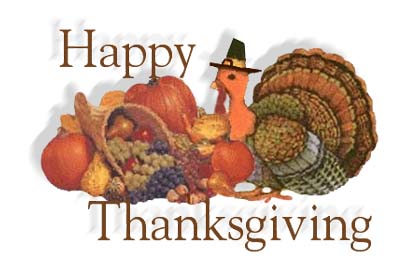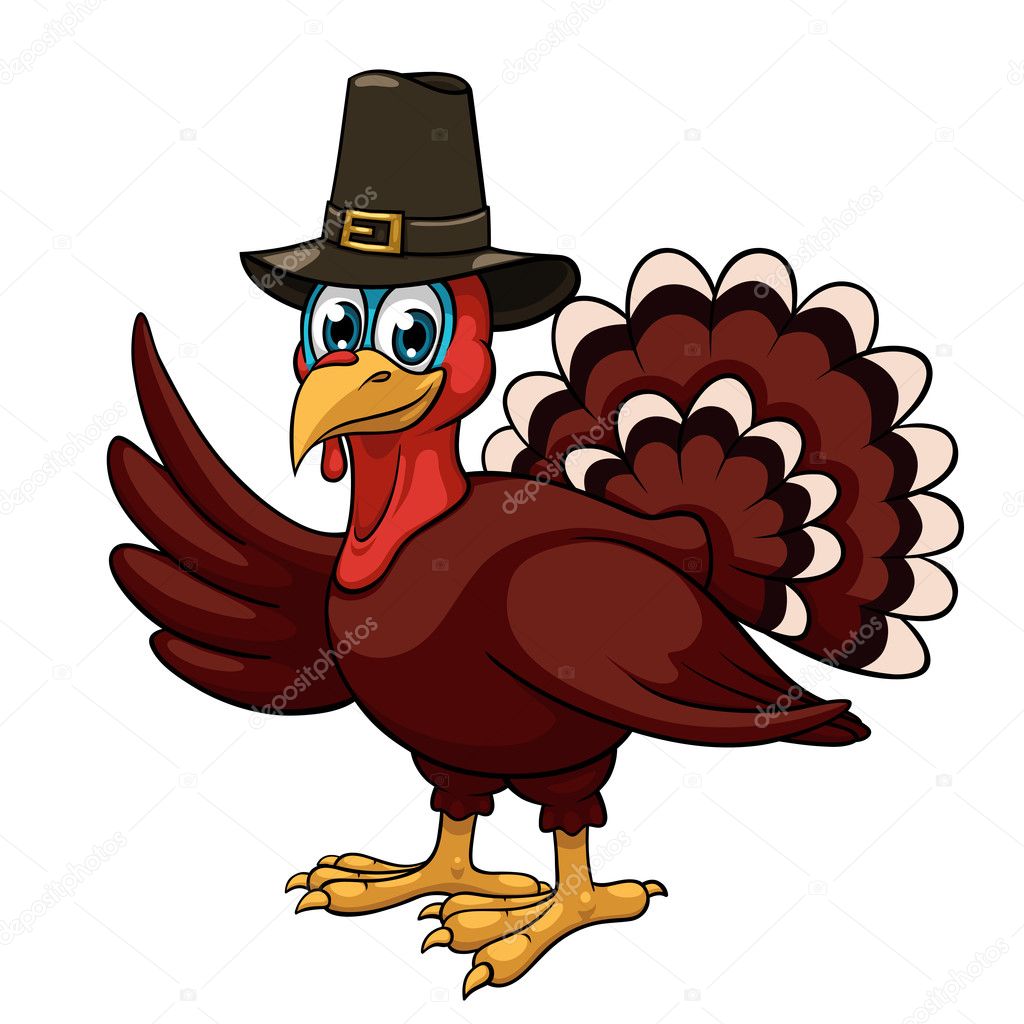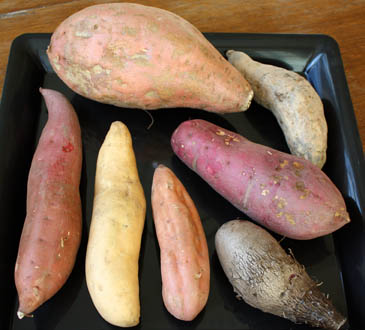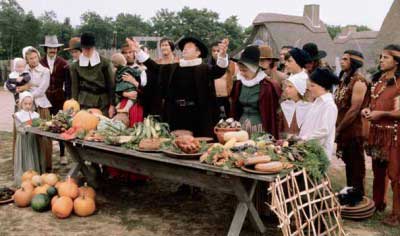Dear students,
Here is a post about Thanksgiving. One part of this post is for Low-Level students, and the other one is for High-Level students.
Please, read this post, watch the animated story about Pilgrims and their first Thanksgiving, try to understand everything. If you see or hear any new words, ask about them. I'll be happy to explain them to you. Enjoy watching the video and have fun!
Irena

Thanksgiving is one of the most popular holidays in the United States of America. Traditionally, Thanksgiving is a holiday that Americans spend together with their families and enjoy a Thanksgiving meal - the traditional Thanksgiving turkey and some vegetables.
We celebrate this holiday on the fourth Thursday in November. We give thanks for everything we have.
For Low Level Students
In 1620 a group of people from England came to North America. They wanted to pray to their God, but the King of England controlled them. They didn't have religious freedom in England, so they came to Plymouth to be free to have their own religion. They came on the ship called "The Mayflower".
Life was difficult in Plymouth. People were sick and hungry. Many of them died. They worked hard. The Native Americans or Indians helped them a lot. They gave the Pilgrims food, showed them how to hunt wild animals and plant food like corn.
Finally, they had enough to eat. In the fall of the next year they had a good crop of different vegetables. To celebrate a good harvest they cooked a large meal and shared it with Indians. They wanted to give thanks for their food. That was the first Thanksgiving Day.
Today people in the United States celebrate Thanksgiving Day. It is always on the fourth Thursday in November. On this day families come together to eat the traditional food of the Pilgrims and the Indians. They eat a lot and talk. They give thanks for their health, their families and friends.
THANKSGIVING EXERCISE (click here for exercise)
Here is a list of some food Pilgrims had:
Fish
Wild turkey
Goose
Duck
Indian corn
Wheat flour
Different berries - cranberries, raspberries, blueberries
Squash
Pumpkin
Beans
Yam or sweet potato
Nuts
Americans celebrate Thanksgiving to give thanks for family, friends, food and health.

For High Level Students
The Pilgrims, who celebrated the first thanksgiving in America, were fleeing religious persecution in their native England. In 1609 a group of Pilgrims left England for the religious freedom in Holland where they lived and prospered. After a few years their children were speaking Dutch and had become attached to the Dutch way of life. This worried the Pilgrims. They considered the Dutch frivolous and their ideas a threat to their children's education and morality.
fleeing = running away from, escaping
prospered = do well, live well
frivolous = not serious
morality = belief system
prospered = do well, live well
frivolous = not serious
morality = belief system
So they decided to leave Holland and travel to the New World. Their trip was financed by a group of English investors, the Merchant Adventurers. It was agreed that the Pilgrims would be given passage and supplies in exchange for their working for their backers for 7 years.
backers = financial supporters
On Sept. 6, 1620 the Pilgrims set sail for the New World on a ship called the Mayflower. They sailed from Plymouth, England and aboard were 44 Pilgrims, who called themselves the "Saints", and 66 others ,whom the Pilgrims called the "Strangers."
The
long trip was cold and damp and took 65 days. Since there was the danger of
fire on the wooden ship, the food had to be eaten cold. Many passengers became
sick and one person died by the time land was sighted on November 10th.
damp = wetsighted = seen
The long trip led to many disagreements between the "Saints" and the "Strangers". After land was sighted a meeting was held and an agreement was worked out, called the Mayflower Compact, which guaranteed equality and unified the two groups. They joined together and named themselves the "Pilgrims."
Although
they had first sighted land off Cape Cod they did not settle until they arrived
at Plymouth, which had been named by Captain John Smith in 1614. It was there
that the Pilgrims decide to settle. Plymouth offered an excellent harbor. A
large brook offered a resource for fish. The Pilgrims biggest concern was
attack by the local Native American Indians. But the Patuxets were a peaceful
group and did not prove to be a threat.
harbor = protected area on the coast
threat = a danger
The first winter was devastating to the Pilgrims. The cold, snow and sleet were exceptionally heavy, interfering with the workers as they tried to construct their settlement. March brought warmer weather and the health of the Pilgrims improved, but many had died during the long winter. Of the 110 Pilgrims and crew who left England, less that 50 survived the first winter.
devastating = extremely difficult
interfering = preventing, making difficult
On March 16, 1621, what was to become an important event took place, an Indian brave walked into the Plymouth settlement. The Pilgrims were frightened until the Indian called out "Welcome" (in English!).
settlement = place to live
His name was Samoset and he was an Abenaki Indian. He had learned English from the captains of fishing boats that had sailed off the coast. After staying the night Samoset left the next day. He soon returned with another Indian named Squanto who spoke better English than Samoset. Squanto told the Pilgrims of his voyages across the ocean and his visits to England and Spain. It was in England where he had learned English.
voyages = travels
Squanto's importance to the Pilgrims was enormous and it can be said that they would not have survived without his help. It was Squanto who taught the Pilgrims how to tap the maple trees for sap. He taught them which plants were poisonous and which had medicinal powers. He taught them how to plant the Indian corn by heaping the earth into low mounds with several seeds and fish in each mound. The decaying fish fertilized the corn. He also taught them to plant other crops with the corn.
sap = the juice of the maple tree
poisonous = food or liquid dangerous to the health
mounds = raising of the earth made of dirt by hand
decaying = rotting
The harvest in October was very successful and the Pilgrims found themselves with enough food to put away for the winter. There was corn, fruits and vegetables, fish to be packed in salt, and meat to be cured over smoky fires.
cured = cooked by smoke in order to keep meat a long time
The Pilgrims had much to celebrate, they had built homes in the wilderness, they had raised enough crops to keep them alive during the long coming winter. They were at peace with their Indian neighbors. They had beaten the odds and it was time to celebrate.
wilderness = uncivilized country
crops = cultivated vegetables such as corn, wheat, etc.
beaten the odds = won something that was very difficult or against somebody
The Pilgrim Governor William Bradford proclaimed a day of thanksgiving to be shared by all the colonists and the neighboring Native Americans. They invited Squanto and the other Indians to join them in their celebration. Their chief, Massasoit, and 90 braves came to the celebration which lasted for 3 days. They played games, ran races, marched and played drums. The Indians demonstrated their skills with the bow and arrow and the Pilgrims demonstrated their musket skills. Exactly when the festival took place is uncertain, but it is believed the celebration took place in mid-October.
proclaimed = declared, named
colonists = original settlers who came to the North America
braves = Indian warrior
musket = type of gun or rifle used during that period in history
The following year the Pilgrims harvest was not as bountiful, as they were still unused to growing the corn. During the year they had also shared their stored food with newcomers and the Pilgrims ran short of food.
bountiful = a lot of
newcomers = people who have recently arrived
The 3rd year brought a spring and summer that was hot and dry with the crops dying in the fields. Governor Bradford ordered a day of fasting and prayer, and it was soon thereafter that the rain came. To celebrate - November 29th of that year was proclaimed a day of thanksgiving. This date is believed to be the real true beginning of the present day Thanksgiving Day.
fasting = not eating
thereafter = after that
The custom of an annually celebrated thanksgiving, held after the harvest, continued through the years. During the American Revolution (late 1770's) a day of national thanksgiving was suggested by the Continental Congress.
harvest = collection of the crops
In 1817 New York State had adopted Thanksgiving Day as an annual custom. By the middle of the 19th century many other states also celebrated Thanksgiving Day. In 1863 President Abraham Lincoln appointed a national day of thanksgiving. Since then each president has issued a Thanksgiving Day proclamation, usually designating the fourth Thursday of each November as the holiday.
Thanksgiving Listening Exercise
Thanksgiving Crossword
Exercise - Thanksgiving Dinner
Now watch this video. Listen carefully, try to understand and remember information.
Here is a short video about the Pilgrims - Life before Thanksgiving. Please, watch it; it's interesting.
And now here is the fun part of the lesson. Here is an animated video about Thanksgiving. Please, watch it carefully. Have fun!
Here is another story about first Thanksgiving - a story
about Squanto, one of the Native
Americans who helped Pilgrims.
Now, here are some questions for discussion. Please, answer them:
1. What season is Thanksgiving Day is in?
2. What month do we celebrate Thanksgiving Day in?
3. When did the Piligrims come to America?
4. Do you celebrate Thanksgiving day?
5. What was the name of their ship?
6. Was their life easy in Plymouth?
7. Where did they come from?
8. Who helped them?
9. What did they do next fall?
10. What are you thankful for?
Here is a Pumpkin Pie Recipe:
Ingredients:
1 cup packed brown sugar
1 tablespoon cornstarch
1/2 teaspoon salt
1 teaspoon ginger
1 teaspoon cinnamon
1 1/2 cups pumpkin purée
3 large eggs
1 1/2 cups evaporated milk
1 9-inch pie shell
Directions:
1. Preheat oven to 425° F. Line a baking sheet with parchment paper; set aside. In a large bowl, combine brown sugar, cornstarch, salt, ginger, cinnamon, pumpkin purée and 3 eggs. Beat well. Add evaporated milk and combine. Set aside.
2. Fill pie shell with pumpkin mixture. Transfer to prepared baking sheet.
3. Bake for 10 minutes. Reduce heat to 350° F and continue baking for 30 more minutes. Cool on a wire rack.
Here is a funny video. Watch it.
Here is a simple Thanksgiving Poem. Read it and write a poem or a paragraph on what you are thankful for. | |||||
| |||||
HAPPY THANKSGIVING DAY!





















No comments:
Post a Comment